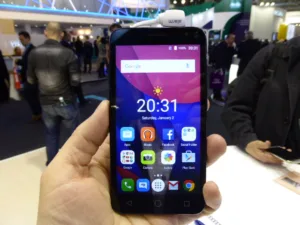TCL subsidiary Alcatel Onetouch rebranded itself to simply ‘Alcatel’ at the show, which it believes will help it reach its millenial target market. The new products are aimed at young adults such as university students and young professionals, and so include VR experiences and DJ mixing software.
In the past, Alcatel has been a value brand – however, its new Idol 4, Idol 4+ and Idol 4S phones, launched at MWC, represent a move to the premium space. These models, a continuation of last year’s Idol 3 range, feature AMOLED displays (1920 x 1080) and octa-core Snapdragon 617 and 652 chipsets.
The three models in the Idol series are the beginning of a convention present in all of Alcatel’s 2016 smartphones: the ‘4’, ‘4+’ and ‘4S’ names. In all series, the ‘4’ phone is the standard model, the ‘4+’ an identical but larger unit and the ‘4S’ a larger, higher-specced handset.
Alcatel’s Pop 4 range features the new Boom butttonEach of the Idol phones features a reversible design, which premiered on last year’s Idol range (Alcatel One Touch Has Lots to Show). This means that turning the phone upside down simply flips the UI, enabling them to be used any way up. They also have a new ‘Boom’ button, the functionality of which changes depending on the app. From standby, it unlocks the phone, launches the camera and takes a picture in less than a second. When listening to music, the key optimises the bass, clarity and volume; and when recording a video, the Boom key will begin a live broadcast (I feel that the Boom key is something of a gimmick in several cases – for instance, it will generate a random effect when watching a video, such as replaying the last second of footage three times. Its use in other applications, such as audio, was gratifying, though. This is thanks to Alcatel’s work with audio brands JBL and Waves – TA).
For the camera, the Idol range features 0.1 – 0.3 second autofocus speeds and a ‘panoramic selfie’. This is exactly what it says on the tin! A user can scroll the phone, just as they do when taking a panoramic picture; the only difference is that it uses the front camera, rather than the rear.
The Idol 4 is 5″, while the 4+ and 4S are 5.5″. All models have 3GB of RAM and octa-core processors; 1.5GHz on the 4, 1.8GHz on 4+ and 4S. Storage is 16GB (4) or 32GB (4+/4S).
Each phone can be used in Google Cardboard-like virtual reality headsets. Alcatel has taken the intriguing move of selling the 4S in a box that turns into a VR headset, which could help to boost VR use – much more than Samsung’s free Gear VR promotion with sales of the Galaxy S7 Edge.
Alcatel will launch the Idol 4 at the end of May, for €280, and the 4+ and 4S in mid-June, for €300 and €450, respectively.

